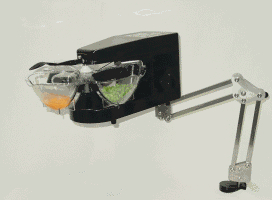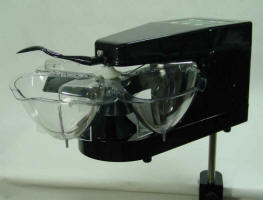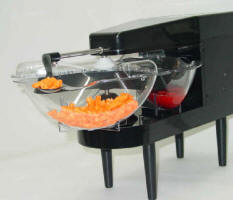Mealtime Partners, Inc.
Specializing in Assistive Dining and Drinking Equipment
August 2012 Independent Eating and Drinking Newsletter
 |
August Topics:
|
||
|
Mealtime Partners Home Page Send a Comment or Suggestion |
|||
| Subscribe to Newsletters |
Conducting a Client Evaluation for a Mealtime Partner Dining System
For those professionals who are new to the world of powered feeding equipment this article will provide guidance for evaluating whether or not the Mealtime Partner Dining System is appropriate for your client.
Prior to evaluating a client for Mealtime Partner use, it is helpful to gather information about the client including:
-
Do they have food allergies? Needless to say, if so, avoid offering these foods.
-
Can they eat any texture of food or do they have difficulties with some items? Only offer food textures that are comfortable and safe for the individual to eat during the evaluation.
-
What foods does the client really love? If possible, use favorite foods during an evaluation to further motivate the individual.
-
How do they currently sit while eating? If the position is safe and comfortable for the user, try and use it while conducting the evaluation. It will be one less new experience for the person to adjust to during the evaluation. However, you may find that you need to modify seating and positioning to improve Mealtime Partner access or to correct posture for safer eating.
-
For how long can you expect to maintain the client’s attention? If the client has a short attention span, you may need to evaluate adaptive switch use at one session and Mealtime Partner use at another session.
-
Have they had any adaptive switch experience (and, if so, what)? Whenever possible use adaptive switches with which the individual is familiar.
-
Which is their dominant hand (if any)? If adaptive switch activation is going to be done using their hands, the dominant hand should be used, if possible.
-
Are there any unusual mealtime practices that should be discussed? If so, they must also be taken into consideration.
When the evaluation begins there are two primary issues that must be resolved: 1. How many, and what types of adaptive switches are to be used and where they will be mounted (our March 2011 Newsletter provides a general overview of adaptive switches). 2. How the Mealtime Partner will be mounted (i.e., positioned for the user). For example, will it be placed directly on a table top or on a table using longer legs to raise it up higher for the user; will it be positioned using Mounting Shafts, or using the Support Arm to hold it out beyond a table.
When deciding which adaptive switches will be used by a specific client, the diagnosis of the client should play a significant role in the selection. Is their disability progressive or static? If their condition is relatively stable, it can be expected that the adaptive switches will be used for an extended time without change. However, if their condition is progressive, extremely light touch or even no-touch switches should be considered to reduce the need for changing adaptive switches as abilities change.
The part of the body that will be used to activate an adaptive switch will usually dictate the appropriate switch. If a hand, or hands, are going to be used (which is typically the first choice for a switch location) the movement pattern(s) of the hand must be evaluated. If a large, or gross movement, is being used (which uses larger muscles to create the movement), a sturdy adaptive switch may be needed, like a Jelly Bean Switch. If a fine motor movement is going to be used for switch activation, a very light touch switch like a Micro Light Adaptive Switch, may be more appropriate.
Switches do not necessarily function best for all individuals when they are placed flat on a surface. Sometimes mounting the switch on a wedge allows the hand, which is resting on the table or laptray, to slide into the switch because the activation surface, or face, of the switch is angled and can be touched without lifting the hand off of the surface on which it is resting. The “slide” movement lessens the occurrence of the hand remaining on the switch unintentionally because it has always remained on the flat surface and only bumped into the switch rather than being placed on and removed from the switch.
Knees, elbows and feet are also good switch activation points. For any of these sites, the switch can be attached to the seating system that is being used for mealtimes. With any of these locations, make sure that the body part does not become displaced from its correct positioning for good posture for eating.
When all other switch locations fail, the head should be considered for activating the switches. When an adaptive switch is mounted for head activation, special attention must be paid to make sure that a chin tuck is still used for every bite of food. Placing a switch on the back of a headrest often tips the head backwards and opens the airway up, thus creating a position that can cause choking. The most desirable switch sites on the head are the front part of the temple (above the outer edge of the eye brows), or the outer part of the cheek bone.
Mounting the Mealtime Partner for each individual depends upon their seating system and how much upper body movement they have. There are several different ways of mounting the Mealtime Partner including using a Mounting Shaft, which allows the Mealtime Partner to be mounted above the table top using a Table Clamp and metal shaft. The device can then be accessed by individuals who are unable to put their knees under the table. The Mealtime Partner can also be mounted on legs and placed on a table top to be used. The legs allow the device to be mounted at the appropriate height for the user (legs are available in several lengths). Also, the Mealtime Partner can be mounted using the Support Arm (using a Table Clamp). This mounting method is of great value to individuals who have extremely limited range of motion.
 |
 |
 |
| Support Arm | Mounting Shaft | Legs |
Of course, throughout the entire evaluation process, seating and positioning for the individual is critical but will not be discussed in this article as it was addressed in the July 2009 Newsletter article: Positioning for Eating; also the closely related topic of buttocks positioning was discussed in the March 2010 Newsletter article: Good Buttocks Positioning Promotes Safe Eating.
As a last piece of advice, don’t take too long on the first evaluation. Eating can be very tiring and when you are trying to undertake new activities, your energy can be quickly depleted. For more information about this topic please refer to the February 2010 Newsletter article: Avoiding Mealtime Fatigue.
The Mealtime Partners website has instructions on how to obtain an evaluation Mealtime Partner Dining System if you need to evaluate a client’s ability to use the equipment prior to purchasing a system. If you need additional assistance with conducting an evaluation for the Mealtime Partner Dining System, please call us at 1-800-996-8607, or send us an email.
|
The Hospital Bed Drinking System |
| Meeting hydration needs for hospital patients who are unable to use their hands or arms to drink. |
The Hospital Bed Hydration System from Mealtime Partners is suitable for patients who have difficulty picking up or holding a cup while lying in bed in the hospital. Adequate hydration is essential for the best medical outcomes for all patients. But, when a patient is unable to take a drink independently, it becomes the responsibility of hospital staff to ensure that adequate water is consumed. However, this increases the workload for staff and it requires the patient to request assistance whenever they are thirsty. |
|
|
| The Mealtime Partners Hospital Bed Hydration System |
Making liquid constantly available allows the user to drink whenever they want. This lowers the risk of dehydration and improves the quality of life for those who have one of these systems. Click on the following link for more information about the Hospital Bed Hydration System. For more information about all of the Mealtime Partners drinking systems and information about choosing the most appropriate drinking system, click here. |
When we get hot, we perspire. It is our body’s way of cooling us down when our body gets too hot. Three things commonly trigger sweating: hot weather (or exposure to high temperature), exercise (i.e., muscle exertion), and nervousness. Many people who are disabled do not manifest perspiring in the same way as their able bodied peers do. For example, many people with quadriplegia caused by a spinal cord injury do not feel heat like their peers, or perspire when they are exposed to warm temperatures. Or, they may perspire only above the level of their spinal cord injury. However, if someone with a spinal cord injury does start to perspire profusely it may be a warning sign of an onset of autonomic dysreflexia which is a very serious condition that can be life threatening. Conversely, perspiring frequently occurs in people who have a disability if they are experiencing pain. Therefore, perspiring cannot be used as an indicator for someone with a disability in the same way it is for those without a disability.
It is very easy for someone who is disabled to become overheated, and as a result, dehydrated, because they do not exhibit the same physical indicators of heat exposure that are commonly seen. Thus if someone is going to be outside for an extended time when it is very hot, their exposure to direct sun, the length of time they are exposed to heat, and the amount of fluid that they consume should all be carefully monitored to avoid problems.
In an opposite situation, many people with disabilities are not outside on a regular basis and thus their skin is not exposed to the sun. Sun exposure is necessary for the production of Vitamin D which is needed for the absorption of calcium by our bodies, which is essential to maintain strong bones. Vitamin D is produced when ultraviolet rays from sunlight strike the skin and trigger vitamin D synthesis. For more information about our body’s need for vitamin D, the Mayo Clinic provides a thorough overview of vitamin D, its value and production.
Another consideration of sun exposure is the risk of skin cancer. We need sun exposure for the production of vitamin D which helps us absorb calcium that is essential for us to have strong, healthy bones, and yet sun exposure can increase our risk of skin cancer. Currently, the general view is that 10 minutes a day of sun exposure is adequate for absorption without excessive risk of skin damage, but this is still being debated.
Another twist to this situation is the use of sun screen. It is recommended that everyone uses SPF 30 (or, greater) sunscreen whenever they are going to be outside, even for a short time. Yet, the use of sunscreen negates the body’s ability to synthesize vitamin D.
These things need to be considered when trips outdoors are being planned. Remember, if you perspire, you will wash off sunscreen and it should be reapplied regularly. Regardless of the sunscreen label’s claim that the product does not wash off in water, the Food and Drug Administration recommends reapplying sunscreen after being in water or sweating.
With all these things in mind, special attention should be taken for safeguarding children and those who are unable to take care of their own needs when they are outside. Not only should their skin be protected from excess sun exposure, they should be dressed in a manner that will protect their skin from the assorted bugs that are prevalent in the summer and can cause serious harm. Also, they should consume plenty of fluids.
With all of these dire conditions it is surprising that we can go out and have fun. Nevertheless, we do and it relieves stress and gives us a change of pace - so go out and enjoy the remainder of the summer. It will be cold soon enough! And remember, a Mealtime Partners hands-free drinking system is available to suit the needs of almost anyone who currently cannot drink without assistance.
| Did You Know? Did you know that many people think that they are choking when they take pills, even though they aren’t? What they feel is the pill sticking to the back of their throat or the top and/or sides of their esophagus. Many medications give people a dry mouth which can contribute to this happening. If they were truly choking, the pill would have gone into their wind pipe and severe coughing would occur. With this situation you simply feel as if you are choking, or you feel as if something is stuck in your chest (which is simply the pill sticking to the sides of the esophagus a little lower down than in the throat). If you experience this phenomenon, take a small drink and rinse out your mouth and throat to make taking pills easier. Take the pill immediately after doing this and take several sips of water or other liquid to “float” the pill down your throat. Do not take a big gulp of liquid. It causes the pill to move around inside the mouth and doesn’t keep it directed towards the back of the throat. |
Mealtime Partners Website Navigation:
Home | Dining | Drinking | Videos | All Products | Warranty | Ordering | Calendar | FAQ | Newsletters | Contact
Please send comments and suggestions to newsletters@mealtimepartners.com
Copyright © Mealtime Partners, Inc. 2012
All rights reserved.